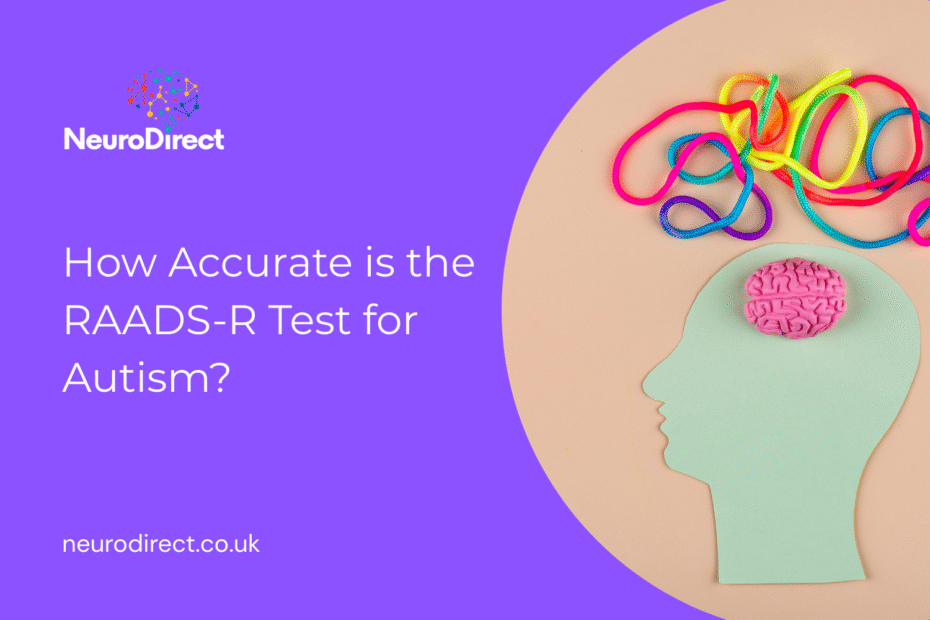How Accurate is the RAADS-R Test for Autism?
When taking an online autism test, one of the first questions people ask is: “But how accurate is it?” The RAADS-R test is widely used as a screening tool, but does it really reflect autistic traits reliably? Let’s explore the research, strengths, and limits of this test.
The Research Behind the RAADS-R
The RAADS-R has been studied in various clinical settings since its creation.
- Validation studies found that it has high sensitivity (meaning it correctly identifies most autistic people) and reasonable specificity (it doesn’t wrongly identify too many neurotypical people).
- For adults who may have “slipped through the cracks” in childhood, it provides an accessible way to highlight autistic characteristics.
Strengths of the RAADS-R
Useful Screening Tool
- Designed specifically for adults, which makes it stand out compared to tests aimed at children.
Broad Coverage
- Questions cover social interaction, communication, sensory traits, and restricted interests, making it more comprehensive than shorter checklists.
Starting Conversations
- The results can be taken to a GP, psychologist, or psychiatrist as a discussion point for pursuing a full assessment.
Limitations of the RAADS-R
Self-Reporting Bias
- Because the answers rely on your self-perception, results can be influenced by mood, memory, or interpretation.
Not a Diagnostic Tool
- The RAADS-R is intended as a screening tool only. A diagnosis requires a full clinical assessment.
Overlap With Other Conditions
- Some answers may reflect traits from ADHD, social anxiety, or OCD, which can affect the accuracy in isolation.
Online vs Clinical Versions
Taking the RAADS-R online is convenient and gives you an immediate score, but it’s worth noting that:
- Clinical versions are scored and interpreted by professionals, often alongside other assessments.
- Online versions are self-scored, which is useful for self-insight but not definitive.
What Do Experts Say About RAADS-R Accuracy?
Several studies have explored the effectiveness of the RAADS-R as a screening tool.
- One peer-reviewed study found the RAADS-R had a sensitivity rate of 97%, meaning it correctly identified the vast majority of autistic individuals.
- Another paper highlighted that while the test is highly effective as a screening tool, it should always be paired with a comprehensive clinical assessment for a reliable diagnosis.
👉 You can read more about the research on the RAADS-R in this PubMed article.
So, How Accurate is It?
- Research suggests the RAADS-R is a strong indicator of autistic traits in adults.
- However, like any self-assessment, it works best as part of a bigger picture.
- The most accurate outcome comes when the RAADS-R is combined with other tests and professional evaluation.
Is the RAADS-R test the same as a diagnosis for autism?
No, the RAADS-R is a screening tool, not a diagnostic assessment. It can highlight autistic traits, but only a qualified clinician can make an official diagnosis.
How long does it take to complete the RAADS-R test?
On average, it takes around 20–30 minutes to answer all 80 questions. The test is detailed, so it’s worth taking your time for accurate results.
What score indicates autism on the RAADS-R test?
Generally, higher scores suggest stronger autistic traits. While research suggests a threshold of 65+ points may indicate traits consistent with autism, interpretation should always be cautious and discussed with a professional.
Can the RAADS-R be used for children?
No — the RAADS-R is designed for adults aged 16 and over. Other tests, such as the CARS (Childhood Autism Rating Scale), are used for younger individuals.
Where can I take the RAADS-R test online for free?
You can take the RAADS-R test for free here. Results are instant, and you’ll also find resources on what to do next if your score suggests significant traits.
Conclusion
The RAADS-R is one of the most accurate self-screening tools for adult autism traits, but it isn’t perfect. Think of it as a reliable first step, not a final answer.
👉 Try the free RAADS-R test here and see how your traits compare — then use your results as a starting point for professional support.
